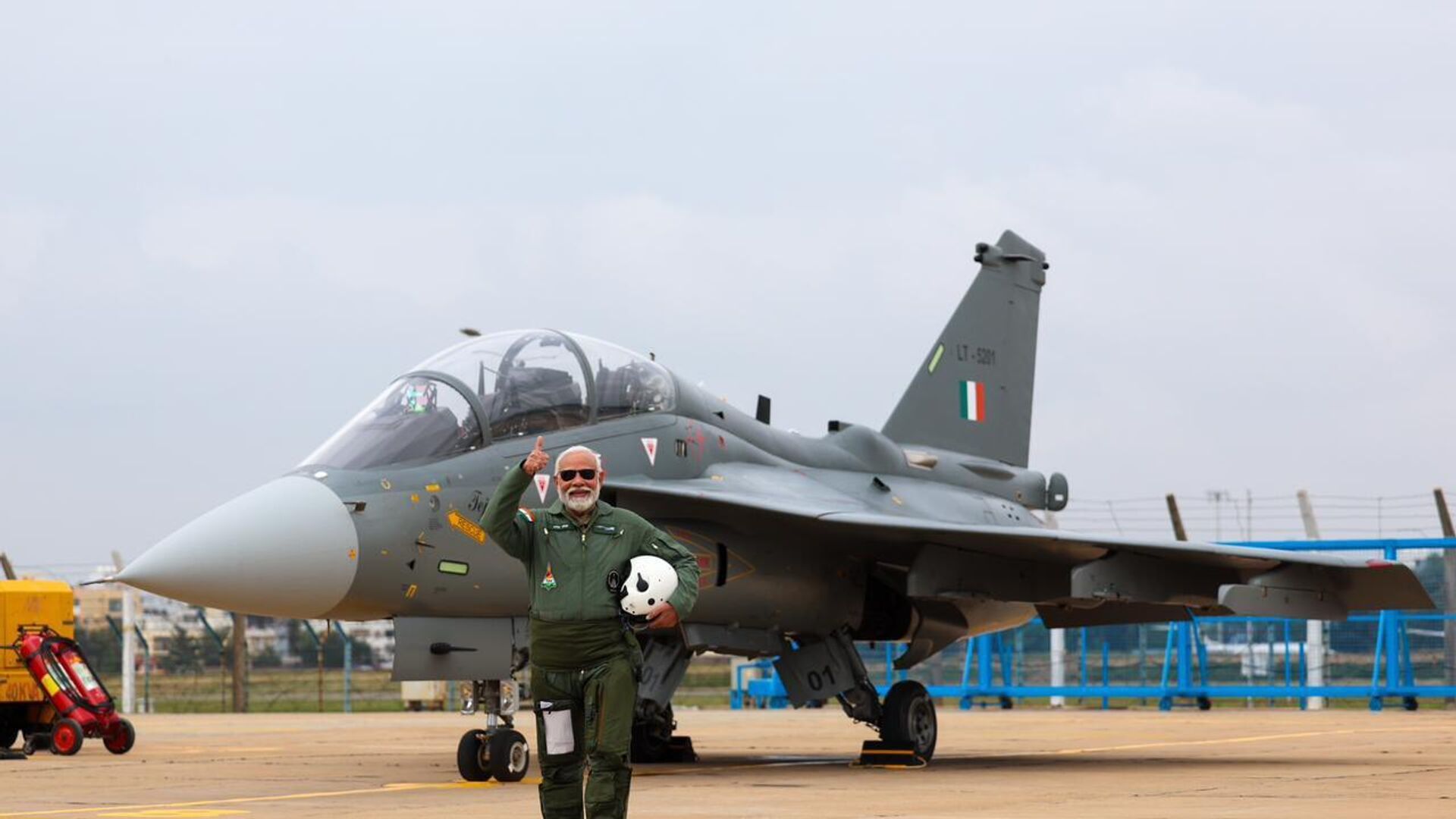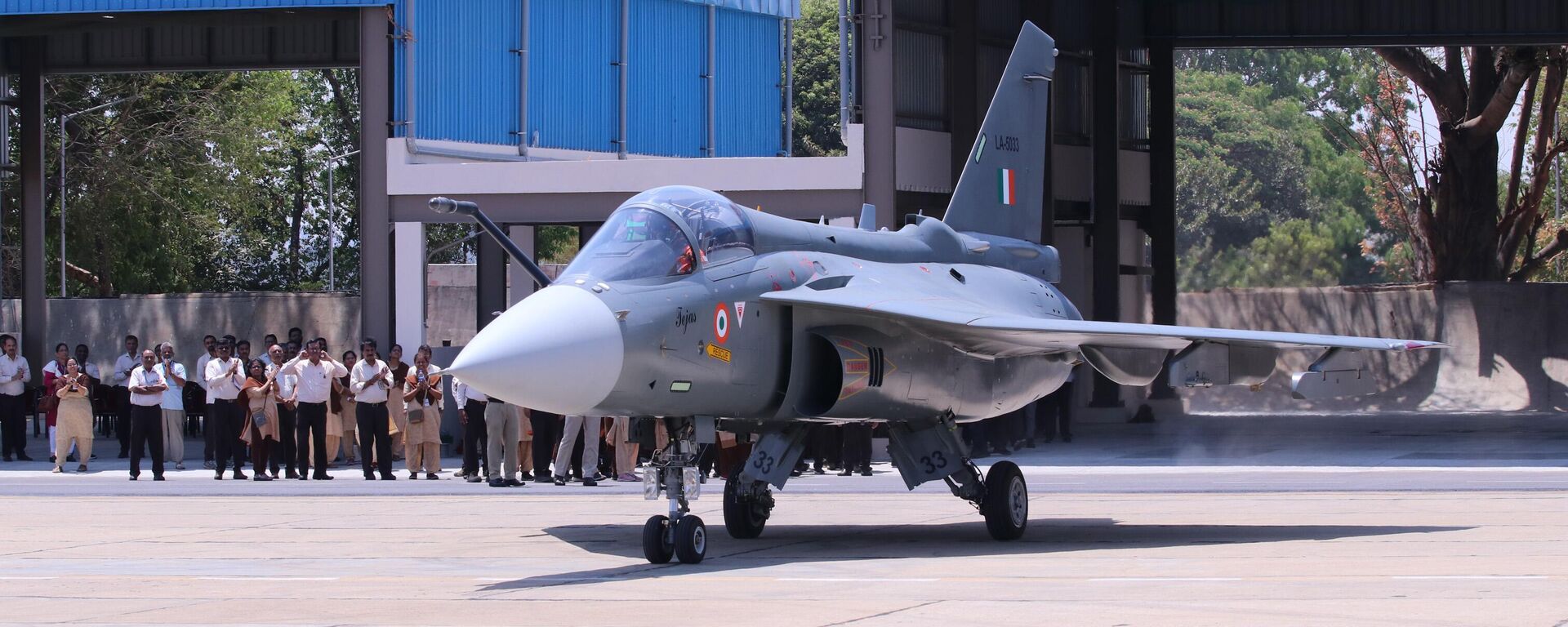https://sputniknews.in/20250102/evolving-landscape-of-5th-and-6th-gen-fighter-jets-whats-indias-strategic-response-8621968.html
Evolving Landscape of 5th and 6th Gen Fighter Jets: What's India's Strategic Response?
Evolving Landscape of 5th and 6th Gen Fighter Jets: What's India's Strategic Response?
Sputnik India
China reportedly unveiled a sixth-generation fighter jet recently, while many other countries, including the UK, France, Italy, and Spain, are also developing... 02.01.2025, Sputnik India
2025-01-02T17:26+0530
2025-01-02T17:26+0530
2025-02-21T19:24+0530
sputnik opinion
india
china
united kingdom (uk)
indian air force (iaf)
hindustan aeronautics limited (hal)
drdo
lca tejas
military equipment
military cooperation
https://cdn1.img.sputniknews.in/img/07e7/0b/19/5576456_0:176:1280:896_1920x0_80_0_0_2bc7d512a158c643dc82af6dc0b0659a.jpg
India should first focus on not only modernising its fleet of combat planes with advanced fighter jets, primarily 4.5-generation, as its air force is short on numbers as far as required squadrons were concerned, experts have said.In late December, China unveiled what Indian aviation pundits believe was a sixth-generation fighter, called the "White Emperor" or "Baidi".Air Marshal (Retd.) Anil Khosla, former vice-chief of the Indian Air Force (IAF), stresses that "China's sixth-generation fighter promises to redefine air warfare in the coming decades".Interestingly, at a time when air power priorities are shifting towards stealth aircraft (5th and 6th generation), the IAF has continued to place orders for the homegrown Light Combat Aircraft (LCA) Tejas, a 4.5-generation warplane.The current order book of the IAF includes 83 Tejas Mk1A and a second contract for 97 units of the aircraft from Hindustan Aeronautics Limited (HAL), with induction expected to start from mid-2025.Rahul Yelwe, senior research fellow at the Centre for Security Studies, School of National Security Studies, Central University of Gujarat, thinks that developing fighter aircraft is a significant investment in defence, whether for 4.5 or 5th generation aircraft. Given India's current economic landscape, it is important to approach this challenge thoughtfully rather than getting drawn into a blind arms race with China, the strategic affairs commentator emphasised. Therefore, a pragmatic and strategic approach for India would be to engage in international collaborations already underway in the realm of sixth generation aircraft development, he highlighted. It is important to note that fifth and sixth generation aircraft come with higher operating costs compared to traditional fourth generation aircraft, making large-scale deployment challenging. Stealth aircraft are often tasked with specialised missions such as the Suppression and Destruction of Enemy Air Defenses (SEAD and DEAD), and air superiority, while a substantial fleet of fourth generation aircraft will continue to play a crucial role at least for the upcoming half-century, the military analyst explained. Dr. Pooja Bhatt, associate professor at Jindal Global University and specialist in Chinese military tactics, underscores that competition with China and other countries on advanced arms and weapon platforms will remain lopsided until India achieves self-reliance in every aspect of defence production and research. On the bright side, Indian political and military leadership is cognisant of this reality, while it is pacing up with advanced defence research and manufacturing, she clarified.Meanwhile, retired IAF Air Vice Marshal Devesh Vatsa urged the Indian authorities to follow a multi-pronged approach to fifth and sixth-generation combat aircraft.Moreover, India should follow a modular design approach that allows for easier upgrades and integration of new technology, Vatsa said, noting that a modular design offers a weapons platform to replace an old module with a more modern, advanced, and altogether new one.
https://sputniknews.in/20241030/tejas-program-delays-why-is-us-undermining-make-in-india-initiative-8341204.html
india
china
united kingdom (uk)
Sputnik India
feedback.hindi@sputniknews.com
+74956456601
MIA „Rossiya Segodnya“
2025
Pawan Atri
https://cdn1.img.sputniknews.in/img/07e6/0c/13/139630_147:0:831:684_100x100_80_0_0_8fa2b25903e7787fe6a2698552c167df.png
Pawan Atri
https://cdn1.img.sputniknews.in/img/07e6/0c/13/139630_147:0:831:684_100x100_80_0_0_8fa2b25903e7787fe6a2698552c167df.png
News
en_IN
Sputnik India
feedback.hindi@sputniknews.com
+74956456601
MIA „Rossiya Segodnya“
Sputnik India
feedback.hindi@sputniknews.com
+74956456601
MIA „Rossiya Segodnya“
Pawan Atri
https://cdn1.img.sputniknews.in/img/07e6/0c/13/139630_147:0:831:684_100x100_80_0_0_8fa2b25903e7787fe6a2698552c167df.png
india, china, united kingdom (uk), indian air force (iaf), hindustan aeronautics limited (hal), drdo, lca tejas, military equipment, military cooperation, ministry of defence (mod), defense sector, joint arms production
india, china, united kingdom (uk), indian air force (iaf), hindustan aeronautics limited (hal), drdo, lca tejas, military equipment, military cooperation, ministry of defence (mod), defense sector, joint arms production
Evolving Landscape of 5th and 6th Gen Fighter Jets: What's India's Strategic Response?
17:26 02.01.2025 (Updated: 19:24 21.02.2025) China reportedly unveiled a sixth-generation fighter jet recently, while many other countries, including the UK, France, Italy, and Spain, are also developing their next-gen warplanes. Sputnik India analyses how India should approach this development.
India should first focus on not only modernising its fleet of combat planes with advanced fighter jets, primarily 4.5-generation, as its air force is short on numbers as far as required squadrons were concerned, experts have said.
In late December, China unveiled what Indian aviation pundits believe was a sixth-generation fighter, called the "White Emperor" or "Baidi".
Air Marshal (Retd.) Anil Khosla, former vice-chief of the
Indian Air Force (IAF), stresses that "China's sixth-generation fighter promises to
redefine air warfare in the coming decades".
Interestingly, at a time when air power priorities are shifting towards stealth aircraft (5th and 6th generation), the IAF has continued to place orders for the homegrown
Light Combat Aircraft (LCA) Tejas, a 4.5-generation warplane.
The current order book of the IAF includes 83 Tejas Mk1A and a second contract for 97 units of the aircraft from
Hindustan Aeronautics Limited (HAL), with induction expected to start from mid-2025.
Rahul Yelwe, senior research fellow at the Centre for Security Studies, School of National Security Studies, Central University of Gujarat, thinks that developing fighter aircraft is a significant investment in defence, whether for 4.5 or 5th generation aircraft.
Given India's current economic landscape, it is important to approach this challenge thoughtfully rather than getting drawn into a blind arms race with China, the strategic affairs commentator emphasised.
"Presently, India faces limitations in its domestic industrial capacity to fully design, develop, and manufacture 4.5-generation aircraft on its own without seeking external assistance for technical consulting or importing crucial components like engines and avionics. The LCA Tejas highlights these challenges", Yelwe told Sputnik India.
Therefore, a pragmatic and strategic approach for India would be to engage in international collaborations already underway in the realm of sixth generation aircraft development, he highlighted.
It is important to note that fifth and sixth generation aircraft come with higher operating costs compared to traditional fourth generation aircraft,
making large-scale deployment challenging. Stealth aircraft are often tasked with specialised missions such as the
Suppression and Destruction of Enemy Air Defenses (SEAD and DEAD), and air superiority, while a substantial fleet of fourth generation aircraft will continue to play a crucial role at least for the upcoming half-century, the military analyst explained.
"The LCA Mark II aims to replace the aging fleet of Mirage 2000, MiG-29, and Jaguar aircraft within the IAF, which totals over 250+ units. By integrating the LCA Mark II into its strategy and pairing it with advanced fifth-generation aircraft, the IAF can effectively enhance its operational capabilities while maintaining cost efficiency. In addition, the LCA II can work to bridge the gap between LCA Mark I and AMCA", Yelwe explained.
Dr. Pooja Bhatt, associate professor at
Jindal Global University and specialist in Chinese military tactics, underscores that competition with China and other countries on advanced arms and weapon platforms will remain lopsided until India achieves self-reliance in every aspect of defence production and research.
On the bright side, Indian political and military leadership is
cognisant of this reality, while it is pacing up with advanced defence research and manufacturing, she clarified.
"Advanced technology-based platforms need a robust, long term and continuing research, and investment. These systems need to be indigenously built as no country transfers its latest technology to other countries. India has embarked on indigenisation much later than US, China, Russia and other European counterparts", Bhatt told Sputnik India.
Meanwhile, retired IAF Air Vice Marshal Devesh Vatsa urged the Indian authorities to follow a multi-pronged approach to fifth and sixth-generation combat aircraft.
"India's attitude towards having next-generation or stealth aircraft should be driven by indigenous development with agencies like Defence Research and Development Organisation (DRDO), HAL, and Aeronautical Development Agency (ADA) driving that innovation. Additionally, India should look at international collaborations to acquire this advanced technology with the South Asian country retaining the intellectual property rights to the final product as New Delhi is yet to develop its own engine for military aircraft", Vatsa said in a conversation with Sputnik India.
Moreover, India should follow a modular design approach that allows for
easier upgrades and integration of new technology, Vatsa said, noting that a modular design offers a weapons platform to replace an old module with a more modern, advanced, and altogether new one.
"However, having the world's most advanced aircraft is no guarantee for a sure shot victory in a battle zone as the men win wars. If one has world-class pilots in the nation's air force, those navigators would be able to negotiate the superiority of the adversary's fighter jets", Vatsa concluded.



